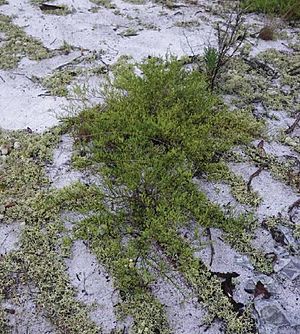Sandlace facts for kids
Quick facts for kids Sandlace |
|
|---|---|
 |
|
| Conservation status | |
| Scientific classification | |
| Synonyms | |
|
Polygonum dentoceras is a special kind of flowering plant. People also call it sandlace, woody wireweed, or Small's jointweed. It is part of the knotweed family.
This plant is very rare. It only grows in Florida, United States. You can find it on the central ridges, like the Lake Wales Ridge. Polygonum dentoceras is an endangered species. This means it is at risk of disappearing forever. Its home is being lost or damaged, which is a big problem.
Contents
About the Sandlace Plant
This plant is a small bush that grows low to the ground. It spreads out like a mat. Its branches can grow up to 2 meters (about 6.5 feet) long. The branches have bark that looks like it's peeling off.
The leaves of the sandlace plant are thin, like needles. They are very small, less than a centimeter long. The plant has tiny flowers, only 1 or 2 millimeters long. These flowers can be white, pink, or yellow. They grow in small groups called an inflorescence.
How the Sandlace Plant Reproduces
The sandlace plant makes new plants in two ways. First, it uses sexual reproduction with its seeds. This is like how many plants make new ones. Second, it can also reproduce vegetatively. This means it makes copies of itself, like clones.
This plant has a cool trick called allelopathy. It releases special chemicals from its roots. These chemicals stop other plants from growing too close to it. This helps the sandlace plant get all the space and nutrients it needs.
Naming the Sandlace Plant
Scientists give plants special names so everyone knows which plant they are talking about. This is called Taxonomy. The sandlace plant has had a few different names over time.
It was first named in 1924 by a scientist named John Kunkel Small. He called it Dentoceras myriophylla. Later, it was moved to a different group of plants called Polygonella. So, its name became Polygonella myriophylla.
In 2015, scientists studied the plant's DNA. They found that Polygonella plants were actually part of the Polygonum group. So, the sandlace plant needed a new name in the Polygonum group. The name Polygonum myriophylla was already taken by another plant. Because of this, scientists gave it the new name Polygonum dentoceras in 2011.
Where Sandlace Lives and How We Protect It
The sandlace plant lives in a special place called the Florida scrub. This is a dry area with white sand. It often grows where Florida rosemary plants are common. You can also find it in oak scrub areas, flatwoods, and sometimes along roadsides or in sandhills.
Animals That Visit Sandlace Flowers
Many small creatures visit the flowers of the sandlace plant. These visitors help the plant by moving pollen. Some of these visitors include a bee called Dialectus placidensis. A type of fly, the shore fly Allotrichoma abdominalis, also visits. And a pretty butterfly, the hairstreak butterfly Hemiargus ceraunus, likes the flowers too.
Threats to the Sandlace Plant
The biggest danger to the sandlace plant is losing its home. People are building more houses and farms, especially citrus groves. This destroys the natural areas where the plant lives.
Another problem is fire suppression. This means stopping wildfires. The Florida scrub habitat needs natural wildfires to stay healthy. The sandlace plant is used to fires. Fires help clear out other plants and make space for it to grow. When fires are stopped, other plants can grow too much and crowd out the sandlace.
In 2010, scientists found about 140 places where this plant grows. It's hard to count exactly how many individual plants there are. This is because one plant can make many clones of itself. So, what looks like many separate plants might actually be copies of just one plant!


